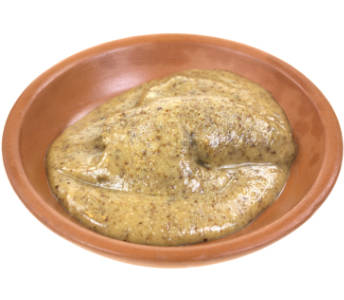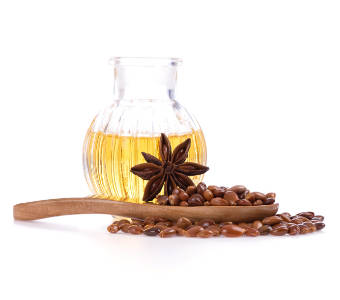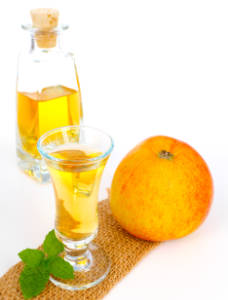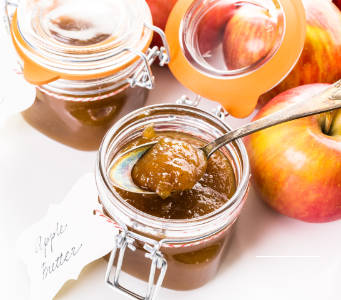Flavorings Category

Includes sweeteners, herbs, spices, chocolate, and extracts.
absinthe
This potent anise-flavored liqueur contains the narcotic herb wormwood, so it isn't available in most developed countries. If you wish to live dangerously, you might be able to find it in Spain.
Learn moreacidulated water
This is water that's been mixed with a small amount of lemon juice or vinegar to make it slightly acidic. If you put freshly sliced fruits or vegetables in acidulated water, they won't darken.
Learn moreaioli
Aioli is usually a mixture of mayonnaise and garlic. But it can be a mixture of olive oil and garlic.
Learn moreajwain
These look like small caraway seeds, but they taste like a pungent version of thyme. Indian cooks like to sprinkle them on breads. Look for them in Indian markets.
Learn morealexanders
Alexanders was a widely used vegetable for centuries. It grows naturally mostly in coastal areas through out Europe and the Mediterranean. Alexanders is attractive because the green shoots are available in the late winter. It has fallen out of favor.
Learn moreallspice
Allspice comes from a single tree, but it tastes like a mixture of cinnamon, cloves, and nutmeg. You can buy it already ground, but for better flavor and a longer shelf life, buy the berries and grind them yourself.
Learn morealmond butter
Almond butter is grittier and more expensive than peanut butter, but it can substitute for peanut butter in many recipes.
Learn morealmond extract
This is made with almond oil and alcohol, and it's especially good in cookies and cakes. It's potent, so recipes usually call for no more than a teaspoon. Bitter almond extract is even stronger.
Learn morealmond paste
This is a paste made with finely ground blanched almonds, sugar, glycerin, and sometimes almond extract. Bakers use it to make cakes and cookies. Bitter almond paste is flavored with oil of bitter almonds, and is worth seeking out if you plan to make amaretti. Look for tubes or cans of it among the baking supplies at your supermarket.
Learn moreamchoor
This is made from sun-dried mangoes, and it's used as a souring agent or to tenderize meats. Indian or Middle Eastern grocery stores carry it.
Learn moreangelica
Angelica is prized for its crunchy stems, which are often candied and used to decorate baked goods. You can also use the leaves and stems to add a celery flavor to liqueurs, sauces, and vegetable side dishes.
Learn moreAngostura® bitters
This famous rum-based brand of bitters was first developed in the 1800s by Simon Bolivar's personal physician. It's 45% alcohol, and comes in small brown bottles with yellow caps. It's now produced in Trinidad.
Learn moreanise extract
This tastes like licorice, and it's typically used to flavor cakes and cookies.
Learn moreanise oil
This imparts a licorice flavor to foods. Look for it near the spices in large supermarkets or in candy supply stores or pharmacies. You can store flavoring oils indefinitely in a cool, dark place.
Learn moreanise seed
Cooks use anise seed to impart a licorice flavor to baked goods, liqueurs, and candies.
Learn moreannatto seeds
Annatto seeds don't have a lot of flavor, but they impart a rich reddish-orange color to stews and sauces. Look for the seeds, either whole or ground, in Latin American or Caribbean markets. To extract the color, steep the seeds in boiling water for about 20 minutes, then discard the seeds.
Learn moreapéritif
Apéritifs are alcoholic drinks that, like appetizers, are served before dinner to perk up the appetite and wake up the taste buds. Examples include fortified wines, herbal and bitter liqueurs, and sparkling wines. Europeans often prefer these over cocktails.
Learn moreapple brandy
This exquisite brandy has a soft apple fragrance. Calvados = calva (cal-VAH-dohs) is the French version, applejack = apple jack is the inferior American version. Calvados is ranked much like cognac. The very best Calvados are labeled Napoleon, Extra Old (XO), Extra, or Hors D'Age. After that comes VSOP, Vieille Reserve, or VO. Next come Vieux or Reserve Calvados, then those with three stars or three apples on their labels.
Learn moreapple butter
Apple butter isn't made from real butter. Instead, it's made by cooking apples until the sugar in them caramelizes, turning the sauce a rich brown color. It's used as a spread, and also as a fat-free substitute in many baking recipes.
Learn moreapple cider
Apple juice and apple cider are very similar, except that all of the apple pulp is filtered out of the juice, while some remains in the cider.
Learn moreapple jelly
You can use this like any other jelly, but it's often used as a glaze when roasting pork.
Learn moreapple juice
Apple juice and apple cider are very similar, except that all of the apple pulp is filtered out of the juice, while some remains in the cider.
Learn moreapplesauce
Applesauce is a purée made from cooked apples. It's often flavored with sugar, lemon juice, and spices like cinnamon and allspice. It's often served as an accompaniment to pork, sausages, and potato pancakes. It can also be used as a fat substitute in baking.
Learn moreapricot brandy
This is distilled from apricot juice. Brands include the French Abricotine, and the Hungarian Barack Pálinka.
Learn moreArmagnac
This French brandy is similar to cognac, but with a more pronounced flavor. Since their quality varies, Armagnac brandies don't share cognac's exalted reputation, but a good Armagnac compares favorably with any cognac.
Learn morearomatized wine
These are wines, like vermouth and retsina, that have been flavored, usually with herbs and spices.
Learn moreasafetida
This powdered gum resin imparts a very strong onion-garlic flavor to Indian dishes. Use it sparingly—a little goes a long way. Look for it in Indian or health food stores or in the spice section of larger supermarkets.
Learn moreAsian barbecue sauce
This is made with oil, soy sauce, and other seasonings. Don't confuse it with the much sweeter American barbecue sauce.
Learn more
































































































































































































































































































































































